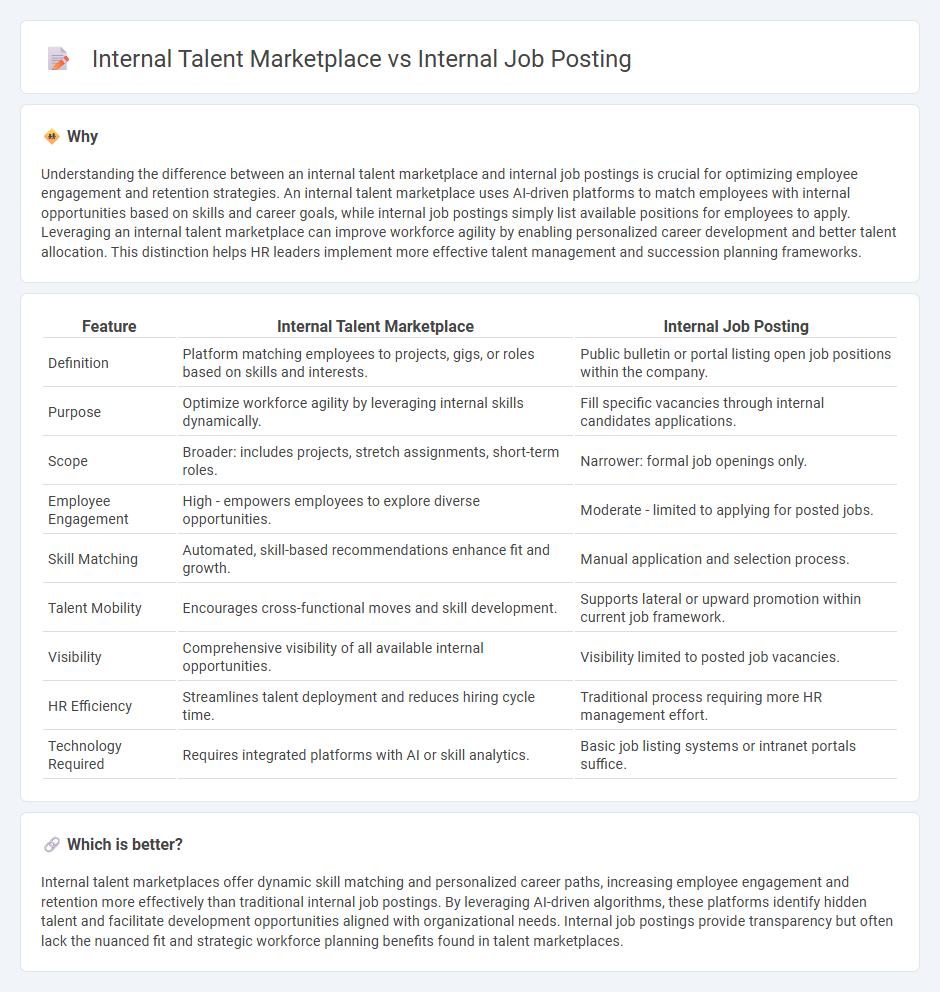
Internal talent marketplaces leverage AI and data analytics to match employees with opportunities tailored to their skills and career goals, boosting engagement and retention. Internal job postings provide a traditional, transparent platform for employees to apply for open roles, enhancing mobility and talent visibility. Explore how these innovative approaches transform talent management and workforce agility.
Why it is important
Understanding the difference between an internal talent marketplace and internal job postings is crucial for optimizing employee engagement and retention strategies. An internal talent marketplace uses AI-driven platforms to match employees with internal opportunities based on skills and career goals, while internal job postings simply list available positions for employees to apply. Leveraging an internal talent marketplace can improve workforce agility by enabling personalized career development and better talent allocation. This distinction helps HR leaders implement more effective talent management and succession planning frameworks.
Comparison Table
| Feature | Internal Talent Marketplace | Internal Job Posting |
|---|---|---|
| Definition | Platform matching employees to projects, gigs, or roles based on skills and interests. | Public bulletin or portal listing open job positions within the company. |
| Purpose | Optimize workforce agility by leveraging internal skills dynamically. | Fill specific vacancies through internal candidates applications. |
| Scope | Broader: includes projects, stretch assignments, short-term roles. | Narrower: formal job openings only. |
| Employee Engagement | High - empowers employees to explore diverse opportunities. | Moderate - limited to applying for posted jobs. |
| Skill Matching | Automated, skill-based recommendations enhance fit and growth. | Manual application and selection process. |
| Talent Mobility | Encourages cross-functional moves and skill development. | Supports lateral or upward promotion within current job framework. |
| Visibility | Comprehensive visibility of all available internal opportunities. | Visibility limited to posted job vacancies. |
| HR Efficiency | Streamlines talent deployment and reduces hiring cycle time. | Traditional process requiring more HR management effort. |
| Technology Required | Requires integrated platforms with AI or skill analytics. | Basic job listing systems or intranet portals suffice. |
Which is better?
Internal talent marketplaces offer dynamic skill matching and personalized career paths, increasing employee engagement and retention more effectively than traditional internal job postings. By leveraging AI-driven algorithms, these platforms identify hidden talent and facilitate development opportunities aligned with organizational needs. Internal job postings provide transparency but often lack the nuanced fit and strategic workforce planning benefits found in talent marketplaces.
Connection
Internal talent marketplaces and internal job postings are interconnected tools that enhance workforce agility by facilitating the seamless matching of employee skills with available job opportunities within an organization. Internal talent marketplaces leverage real-time data and AI-driven algorithms to dynamically connect employees to internal job postings, projects, and gig assignments based on their competencies, career aspirations, and organizational needs. This integration improves employee retention, accelerates skill development, and maximizes talent utilization across departments.
Key Terms
**Internal Job Posting:**
Internal job posting allows organizations to advertise open positions exclusively to current employees, promoting career growth and retention by providing clear visibility into available roles. This approach leverages existing talent, reduces hiring costs, and supports employee engagement by encouraging internal mobility within the company. Explore more about how internal job posting can transform your workforce strategy today.
Vacancy Announcement
Vacancy announcements in internal job postings typically highlight specific open roles within an organization, targeting current employees for direct application, ensuring transparency and internal mobility. In contrast, internal talent marketplaces use broader vacancy announcements that emphasize skill needs and project opportunities, promoting a dynamic match between employee capabilities and organizational demands. Explore how vacancy announcements transform internal recruitment by integrating traditional postings with talent marketplaces.
Application Process
Internal job postings typically involve employees applying manually through a company's career portal, requiring them to actively seek and submit applications for available positions. Internal talent marketplaces leverage AI-driven platforms that automatically match employee skills with open roles, streamlining the application process and enhancing visibility of opportunities. Explore how these innovative systems transform career mobility and optimize talent acquisition within organizations.
Source and External Links
10 Helpful Examples of an Internal Job Posting Template - This webpage provides templates and examples to help create effective internal job postings.
Internal Job Posting | Meaning and Definition - This article explains the definition and benefits of internal job postings, including career progression and cost savings.
Internal Job Posting: Everything HR Needs to Know - This resource guide covers the process and strategy behind internal job postings, including setting up an internal job board.
 dowidth.com
dowidth.com